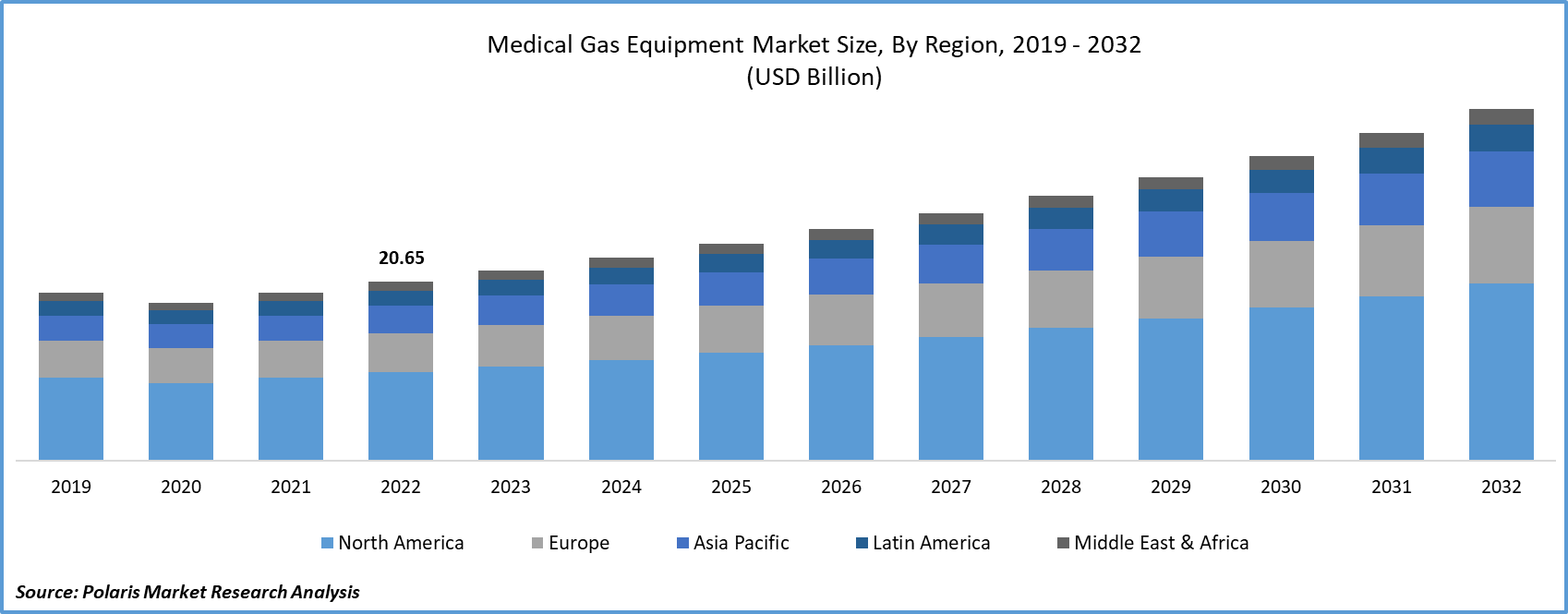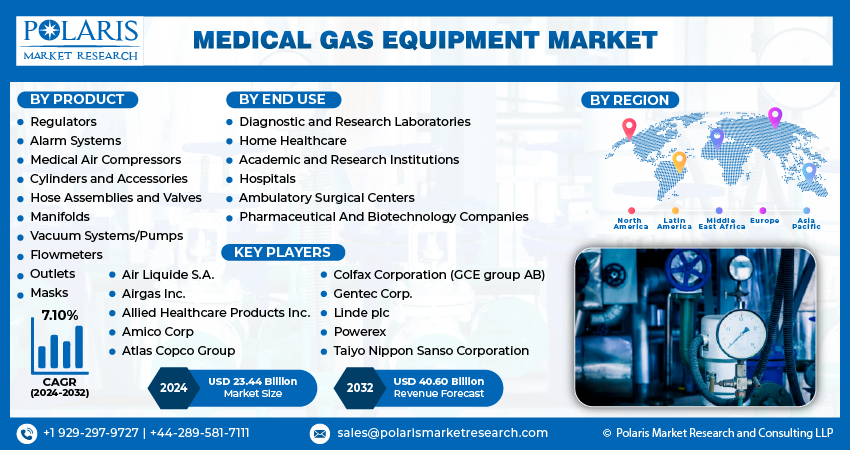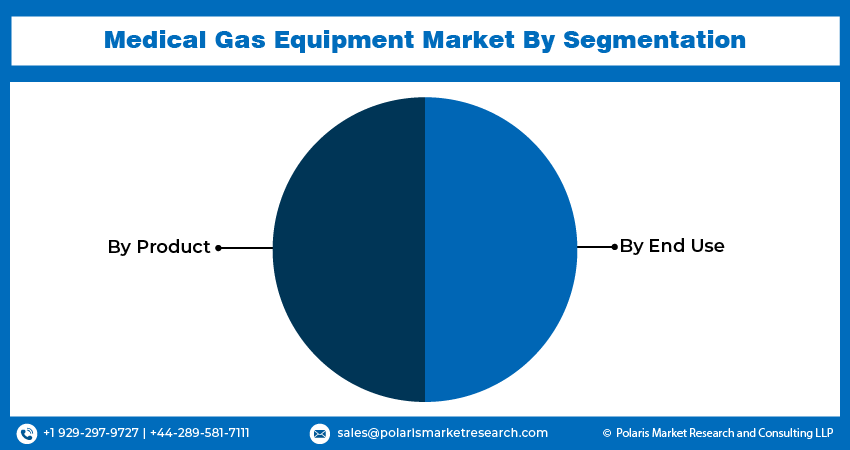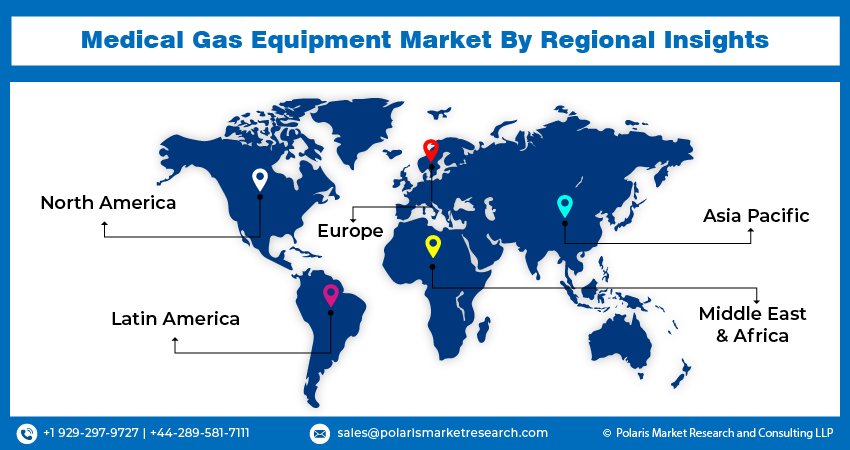
Medical Gas Equipment Market Share, Size, Trends, Industry Analysis Report, By Product (Regulators, Alarm Systems, Medical Air Compressors, Cylinders and Accessories, Hose Assemblies and Valves, Manifolds, Vacuum Systems/Pumps, Flowmeters, Outlets, Masks); By End-Use; By Region; Segment Forecast, 2024- 2032
- Published Date:Jan-2024
- Pages: 116
- Format: PDF
- Report ID: PM4021
- Base Year: 2023
- Historical Data: 2019-2022
Report Outlook
The global medical gas equipment market size and share was valued at USD 21.99 billion in 2023 and is expected to grow at a CAGR of 7.10% during the forecast period.
The market is experiencing growth due to various factors, including an increase in surgical procedures and hospital admissions, along with an aging population. Consequently, there is a rising demand for equipment that can effectively and safely administer gases to patients. Advancements like digital flow meters, remote monitoring systems, and wireless connectivity have enhanced the efficiency, reliability, and safety of these devices. Furthermore, the expanding healthcare expenditure, the surging demand for home healthcare services, and point-of-care diagnostics are propelling the market forward. In addition to these factors, escalating pollution levels and the prevalence of tobacco use are contributing to an increased need for respiratory support, which further stimulates market growth.
Medical gases, which are used during medical procedures, are crucial for the functioning of hospitals and several other healthcare facilities. The delivery of these gases takes place through a piping network through a central source. In some cases, the gases may be supplied via cylinders or a pipeline. There are several gases used in hospitals, with the most common ones being medical air, oxygen, nitrous oxide, nitrogen, and carbon dioxide. Medical air is widely used to keep patients comfortable and breathing, whereas oxygen is used for resuscitation and inhalation therapy.
Medical gas equipment encompasses several products, including regulators, alarm systems, cylinders and accessories, hose assemblies and valves, manifolds, vacuum systems, flowmeters, and more. Gas regulators are used to control the flow of gas through the equipment. Manifolds act as a gas distribution device that brings many junctions into one place. The rising utilization of point-of-care diagnostics is one of the primary factors driving the medical gas equipment market growth.

To Understand More About this Research: Request a Free Sample Report
Respiratory ailments continue to pose a significant global healthcare challenge, contributing substantially to non-communicable disease-related fatalities. Leading the list are conditions like asthma, pneumonia, and COPD. Oxygen therapy is a key treatment for chronic lung conditions, such as COPD, alleviating the workload on the heart rather than the lungs and helping prevent pulmonary artery hypertension. The growing prevalence of these respiratory disorders is spurring growth in the medical gases and equipment market. To cater to the increasing demand for dependable, secure, and efficient respiratory care, there is a rising utilization of equipment like vacuum systems/pumps, alarm systems, flowmeters, manifolds, and others. The market's expansion is also being fueled by notable advancements made by major industry players.
- For instance, In January 2023, Atlas Copco, a prominent manufacturer of industrial tools and equipment, completed the acquisition of MedCore Services Inc., specializing in the maintenance and servicing of medical gas systems. This strategic acquisition is anticipated to augment Atlas Copco's product portfolio and broaden its market presence in the field of medical gas equipment. The acquisition underscores the company's dedication to delivering top-tier, dependable equipment tailored to the evolving requirements of healthcare practitioners and patients.
We strive to offer our clients the finest in market research with the most reliable and accurate research findings. We use industry-standard methodologies to offer a comprehensive and authentic analysis of the Medical Gas Equipment Market. Besides, we have stringent data-quality checks in place to enable data-driven decision-making for you.
The market report provides a thorough analysis of the medical gas equipment market, covering all the major aspects stakeholders need to know. It sheds light on the key developments and trends that are anticipated to drive the medical gas equipment industry demand over the forecast period. Besides, it maps the qualitative impact of various key factors on market segments and geographies. Furthermore, it examines the key steps taken by industry participants to strengthen their presence in the industry.

Industry Dynamics
Growth Drivers
- Increasing Utilization of Point-of-Care Diagnostics Facilitate Market Growth
The advancement of point-of-care diagnostics (POCD) and the growing incidence of respiratory disorders are poised to exert a significant influence on the medical gas equipment market. The demand for medical gases and equipment, especially in the home healthcare sector, may necessitate the implementation of POCD. POCD, a widely employed diagnostic method, allows for the rapid diagnosis of illnesses right at the patient's bedside, outperforming other diagnostic approaches. With the increased risk of disease transmission in healthcare facilities, the rising prevalence of respiratory conditions is expected to drive the adoption of POCD.
Moreover, the increasing identification of conditions that lead to immobility is anticipated to boost the demand for medical gases and home healthcare supplies. To succeed in the competitive medical gas and equipment market, it may be imperative for leading competitors to innovate and tailor new products to meet the specific needs of consumers. Consumers are increasingly recognizing the benefits of integrating a pressure regulator and a cylindrical valve into a single device capable of handling all essential control functions.
Report Segmentation
The market is primarily segmented based on product, end-use, and region.
|
By Product |
By End Use |
By Region |
|
|
|
To Understand the Scope of this Report: Speak to Analyst
By Product Analysis
- The Vacuum Systems/Pumps segment held the largest revenue share in 2022
Market growth can be attributed to factors such as increased utilization and elevated pricing. With the growing complexity and diversity of medical procedures, the incorporation of vacuum systems and pumps has become indispensable for the safe and efficient administration of medical gases. Furthermore, advanced equipment can deliver precise and dependable suction power, a crucial aspect in surgical procedures where fluid and gas suction is of paramount importance for patient safety.
Masks are notably appealing in the market landscape, primarily due to their cost-effective production and widespread use. Consequently, they are poised for substantial growth in the foreseeable future. Likewise, regulators and medical gas outlets are also anticipated to undergo significant expansion. The increasing focus on safety-related initiatives has prompted numerous key players to frequently enhance their product offerings, a trend expected to propel the growth of these segments in the forecast period.
Conversely, in 2022, the manifolds segment secured the significant market share. Manifolds play a crucial role in delivering a consistent flow of medical gases to pipeline systems within medical institutions. Their pivotal role in gas transportation significantly contributes to market expansion. Additionally, the escalating requirement for medical gases within hospitals and ambulatory surgical centers is fueling the demand for manifolds, consequently fostering market growth.
By End-Use Analysis
- The Hospitals segment accounted for the highest market share during the forecast period
Medical gas equipment plays a crucial role in various medical procedures, prioritizing patient safety and well-being. This category encompasses gas cylinders, pressure regulators, flow meters, and other apparatus designed to manage gas flow and pressure. The demand for medical gases is closely linked to the upsurge in hospital activities. For example, an increase in surgical interventions leads to a higher consumption of gases like nitrous oxide, carbon dioxide, oxygen, and medical air. Likewise, a rise in outpatient procedures results in elevated oxygen consumption.
The home healthcare sector is expected to experience the most rapid CAGR in the near future. It provides patients with the opportunity to receive medical care within the comfort of their own homes. In the realm of home healthcare, medical gases like oxygen and nitrogen are employed in the treatment of individuals with respiratory ailments or chronic obstructive pulmonary disease (COPD). Patients can utilize portable oxygen concentrators or receive compressed gas cylinders, which are conveniently delivered to their residences and connected to oxygen delivery systems.
There have been remarkable advancements in medical gas cylinder technology, ushering in the era of lightweight composite cylinders with non-limited life (NLL). These cylinders hold the promise of exerting a significant influence on homecare treatments, portable oxygen therapies, and medical gas applications in the near term. Patients receiving healthcare at home stand to gain from these cylinders, given their substantial weight advantage over traditional aluminum counterparts. These progressive developments in medical gas equipment are pivotal drivers of market growth.

Regional Insights
- North America dominated the largest market in 2022
In 2022, North America's market leadership was driven by its advanced healthcare system, a significant prevalence of minimally invasive procedures, and the implementation of regulatory measures, including the U.S. Food and Drug Administration Safety and Innovation Act. The demand for essential respiratory support devices such as oxygen concentrators and ventilators in the region surged due to the COVID-19 pandemic, underscoring the heightened importance of medical gas equipment in patient care.
Europe is poised for substantial expansion in the foreseeable future. This projection is underpinned by the region's ongoing growth, driven in part by the active involvement of entities like the European Industrial Gases Association and the Medical Gas Association, which advocate for the advancement and acceptance of medical gas equipment in the region. Furthermore, the well-established healthcare systems in Western European nations are expected to act as catalysts for the European market's growth.
Furthermore, the growth of the European market is being propelled by the increasing utilization of home healthcare settings in nations like the United Kingdom, France, Italy, and more. The World Health Organization (WHO) has observed a consistent rise in life expectancy in the region over recent years. It is expected that the growing population of elderly individuals in need of care in Europe will have a substantial impact on the home care sector in the near future, thereby positively impacting the market.

Key Market Players & Competitive Insights
The market is characterized by intense competition, with established players relying on advanced technology, high-quality products, and a strong brand image to drive revenue growth. These companies employ various strategies such as research and development, mergers and acquisitions, and technological innovations to expand their product portfolios and maintain a competitive edge in the market.
Some of the major players operating in the global market include:
- Air Liquide S.A.
- Airgas Inc.
- Allied Healthcare Products Inc.
- Amico Corp
- Atlas Copco Group
- Colfax Corporation (GCE group AB)
- Gentec Corp.
- Linde plc
- Powerex
- Taiyo Nippon Sanso Corporation
Recent Developments
- In March 2023, Atlas Copco AB revealed its acquisition of the operational assets of the FS Medical Technology Business. FS Medical Technology is involved in the sale, inspection, and testing of piped medical and laboratory gas equipment and systems.
- In October 2022, ESAB Corporation, a renowned global player in fabrication and gas control technology, disclosed that it has completed a cash transaction of USD 127 million to acquire Ohio Medical, LLC ("Ohio Medical"), a prominent global leader in oxygen regulators and central gas systems, from a private investor group.
Medical Gas Equipment Market Report Scope
|
Report Attributes |
Details |
|
Market size value in 2024 |
USD 23.44 billion |
|
Revenue Forecast in 2032 |
USD 40.60 billion |
|
CAGR |
7.10% from 2024 – 2032 |
|
Base year |
2023 |
|
Historical data |
2019 – 2022 |
|
Forecast period |
2024 – 2032 |
|
Quantitative units |
Revenue in USD billion and CAGR from 2024 to 2032 |
|
Segments Covered |
By Product, By End-Use, By Region |
|
Regional scope |
North America, Europe, Asia Pacific, Latin America; Middle East & Africa |
|
Customization |
Report customization as per your requirements with respect to countries, regions and segmentation. |
Explore the landscape of Medical Gas Equipment Market in 2024 through detailed market share, size, and revenue growth rate statistics meticulously organized by Polaris Market Research Industry Reports. This expansive analysis goes beyond the present, offering a forward-looking market forecast till 2032, coupled with a perceptive historical overview. Immerse yourself in the depth of this industry analysis by acquiring a complimentary PDF download of the sample report.
Browse Our Top Selling Reports
Seed Cracker Market Size, Share 2024 Research Report
Subcutaneous Immunoglobulin Market Size, Share 2024 Research Report
Antiparasitic Drugs Market Size, Share 2024 Research Report
Corticosteroids Market Size, Share 2024 Research Report
Carboprost Tromethamine Market Size, Share 2024 Research Report
